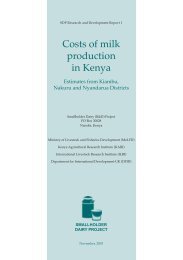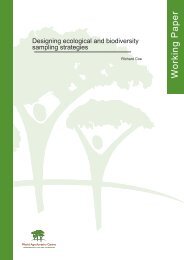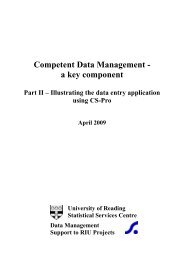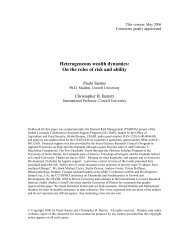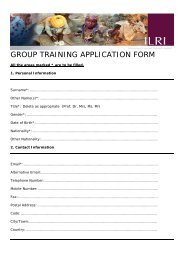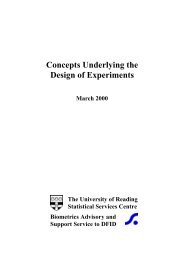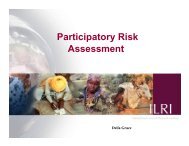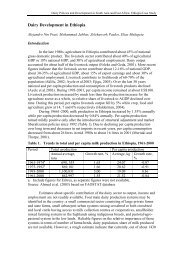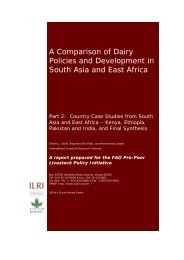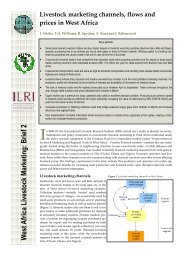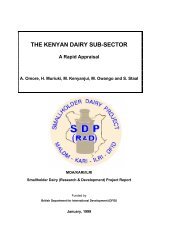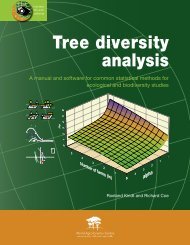Improvement of Livestock Production in Crop-Animal Systems in ...
Improvement of Livestock Production in Crop-Animal Systems in ...
Improvement of Livestock Production in Crop-Animal Systems in ...
Create successful ePaper yourself
Turn your PDF publications into a flip-book with our unique Google optimized e-Paper software.
There is wide <strong>in</strong>tegration <strong>of</strong> animals (both rum<strong>in</strong>ants and non-rum<strong>in</strong>ants) <strong>in</strong> many differentcomb<strong>in</strong>ations with crops and aquaculture. Rum<strong>in</strong>ants are grazed largely on native pastures <strong>in</strong> semi-<strong>in</strong>tensivesystems, although dairy cattle <strong>in</strong> peri-urban situations are stall-fed <strong>in</strong> semi-<strong>in</strong>tensive and <strong>in</strong>tensive systems.Non-rum<strong>in</strong>ants, cattle and goats are <strong>in</strong>tegrated <strong>in</strong>to complex systems on small farms with annual and perennialcrops and aquaculture. Examples <strong>of</strong> <strong>in</strong>tegrated systems <strong>in</strong>clude:• Pigs–duck–chicken–vegetables–fruit–aquaculture.• Pigs–ducks–goats–rice–vegetables–aquaculture.• Pigs–ducks–cattle–vegetables–aquaculture.• Goats–fruit–pigs–aquaculture.The process enables diversified use <strong>of</strong> resources, <strong>in</strong>creased food production and <strong>in</strong>come, and thegeneration <strong>of</strong> biogas for household use. Risks are also reduced <strong>in</strong> such systems. Interviews with farmerssuggest that they believe <strong>in</strong> the susta<strong>in</strong>ability <strong>of</strong> these systems which enhance their livelihoods and foodsecurity.In the peri-urban areas <strong>of</strong> Ho Chi M<strong>in</strong>h City, over 50,000 litres <strong>of</strong> fresh milk was produced <strong>in</strong> 1991,mostly by smallholders (87%). Some 30–40% <strong>of</strong> fresh milk was processed at farm level <strong>in</strong>to various dairyproducts and sold directly to neighbours, local shops and markets. The rema<strong>in</strong>der was sold through a network<strong>of</strong> 15 cool<strong>in</strong>g plants to government milk factories for process<strong>in</strong>g and retail<strong>in</strong>g. Some research has been<strong>in</strong>itiated to improve feed<strong>in</strong>g systems <strong>of</strong> dairy cattle (IAS 1995).Feed resourcesThe diversity <strong>of</strong> crops grown <strong>in</strong> the country is reflected <strong>in</strong> the range <strong>of</strong> crop residues and AIBP that areavailable, yet rema<strong>in</strong> under-utilised. No accurate statistics could be found on the total volume produced, butdata are available on the chemical composition <strong>of</strong> various feeds. Notwithstand<strong>in</strong>g the <strong>in</strong>tensive dairy systems,where some 332,000 ha are <strong>in</strong> planted pasture (ma<strong>in</strong>ly Napier grass), most <strong>of</strong> the forages fed to rum<strong>in</strong>antscome from native pasture (one million ha) on roadsides and bunds, <strong>in</strong> rice stubble and <strong>in</strong> some grasslandareas. However, most <strong>of</strong> the best native grasslands have been reclaimed for crop production or re-settlement.Fallow land under shift<strong>in</strong>g cultivation is dom<strong>in</strong>ated by I. cyl<strong>in</strong>drica, whilst the prevalence <strong>of</strong> C. odorata isalso a problem <strong>in</strong> some areas. Available native pastures tend to be overgrazed and there is no formalmanagement <strong>of</strong> graz<strong>in</strong>g. Legumes are used sparsely although <strong>in</strong>creas<strong>in</strong>g attention is be<strong>in</strong>g given tomultipurpose trees such as L. leucocephala. Locally produced oil cakes and meals from peanut, soyabean,coconut and fish are the ma<strong>in</strong> source <strong>of</strong> prote<strong>in</strong>s, especially for non-rum<strong>in</strong>ants and dairy cattle.Several bilateral aid agencies are work<strong>in</strong>g <strong>in</strong> Vietnam to improve feed utilisation with the NARS.Interventions such as urea-treated rice straw and multi-nutrient blocks for rum<strong>in</strong>ants and sugar-cane juice forpigs are be<strong>in</strong>g tested, and are mak<strong>in</strong>g collectively a significant improvement <strong>in</strong> the efficiency <strong>of</strong> use <strong>of</strong> locallyavailable feed resources.<strong>Animal</strong> health and diseasesTable A6 presents some animal diseases that have been diagnosed as be<strong>in</strong>g present <strong>in</strong> Vietnam. <strong>Animal</strong>diseases have not been well studied, and there is uncerta<strong>in</strong>ty as to whether or not many <strong>of</strong> them actually occur<strong>in</strong> the country. Epidemiological data are not available, mak<strong>in</strong>g it difficult to make the correct decisions.The lack <strong>of</strong> adequate veter<strong>in</strong>ary <strong>in</strong>puts and services is a major constra<strong>in</strong>t to the development <strong>of</strong> animalproduction <strong>in</strong> Vietnam, and must be greatly improved <strong>in</strong> the future. Some simple vacc<strong>in</strong>es, antibiotics anddrugs are produced from imported <strong>in</strong>gredients but are generally <strong>in</strong> short supply and <strong>of</strong> low quality. Antibioticscan be obta<strong>in</strong>ed easily and many farmers treat their own animals. Priority <strong>in</strong> disease control and preventionis given to production zones, ma<strong>in</strong>ly <strong>in</strong> the south. Farmers <strong>in</strong> peri-urban areas receive good veter<strong>in</strong>ary attentionfrom government services, whereas those <strong>in</strong> rural areas have less access to government veter<strong>in</strong>ary services.



